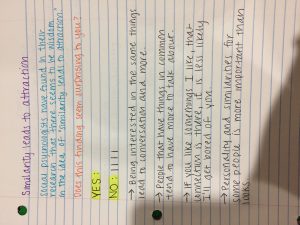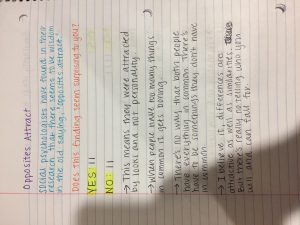Artifact #5
Module 11: Prosocial Behavior

Please write down the initials of 10 people you know fairly well. Then, beside each name, write down whether you think the person is happy (H) or unhappy (UH), and whether you would consider them selfish (S) or unselfish (US).
Person H or UH S or US
-
- Telly __H___ __US___
- Nicole __H___ __US___
- Aleasia __U___ __US___
- Mackenzie __H___ __US___
- Denae __H___ __US___
- Simone __H___ __S___
- Courtney __U___ __S___
- Tia __U___ __S___
- Tanairy __U___ __US___
- Nini __H___ __US___
Please code the number of people from above who fall into each of the four cells below. For example, if you have three unhappy/selfish people then put a “3” in the unhappy-selfish cell.
Happy Unhappy
Selfish |
1 | 2 |
Unselfish |
5 | 2 |
Artifact #4
Module 10: Social Influence

There are many implicit norms that people are used to so seeing someone do the opposite of that it may be a problem. You can get stares or people may react a certain way. For this little experiment, the first thing that popped into my head was putting my feet up on the table. Not just putting my feet up, my bare feet and putting my socks on the table at the library. I got a lot of stares and it was a little embarrassing but my friends helped me laugh it off. This is an example of an interpersonal behavior because it is not normal to put your feet on the table.
It was almost midnight when I decided to do this experiment. The library was full of students who were studying and doing homework. I went over to an area where people were on computers and I took my socks off and proceeded to put my feet on the table while getting on the computer to do homework. There was a mix of men and women and they all looked around the age of 18 to mid-twenties. I think that this experiment would have been worse to do somewhere else, especially like a restaurant, but in college, it’s like it is weird, but it’s college so some people don’t care.
Artifact #3
Module 8:

Results of Survey on Stereotypes
Group Katz & Braly (1933) Gilbert (1951) Your Class
Americans industrious/intelligent materialistic/intelligent Cruel + Lazy
Chinese superstitious/sly family-oriented/ Intelligent + Reserved
tradition-loving
English athletic/intelligent tradition-loving/reserved Nationalistic + Reserved
Germans scientifically-minded/ scientifically-minded/ Hostile + Sly
industrious industrious
Irish hostile/quick-tempered quick-tempered/religious Quick Tempered + Scientifically-minded
Italians artistic/impulsive religious/artistic Artistic + Family-Oriented
Japanese intelligent/industrious deceptive/sly Superstitious + Materialistic
Jews shrewd/selfish shrewd/intelligent Selfish + Religious
Blacks superstitious/lazy superstitious/musical Athletic + Impulsive
Stereotypes are beliefs from a particular person or thing that have been oversimplified. Looking at my results and the results of Katz & Braly and Gilbert, they are very inconsistent. The only ones that match were the ones for English, Irish, Jews, and Italians and that was only for one trait. Over the years, stereotypes haven’t really changed much because once a stereotype starts it is hard to make it disappear. If anything, stereotypes have gotten worse and have transitioned to even more horrible things. Black stereotypes, in my opinion have not gotten better, they are more degrating and probably one of the worst stereotypes.
Artifact #2
Module 7: The Self
 First, please complete the survey below:
First, please complete the survey below:
Attitude Survey
Please indicate your degree of agreement or disagreement with each of the following statements:
- Students will speak out more during a lecture if they have read the assigned reading.
1 2 3 4
disagree agree
- Wearing a seatbelt significantly reduces the chance of suffering a serious injury in a car accident.
1 2 3 4
disagree agree
- Homelessness is a serious social problem that needs attention.
1 2 3 4
disagree agree
- Engaging in regular physical exercise several times a week promotes good health.
1 2 3 4
disagree agree
- Recycling is a great way to protect the environment.
1 2 3 4
disagree agree
- Designating a non-drinking driver can reduce the chance of being in an alcohol-related accident.
1 2 3 4
disagree agree
After completing the survey above, please complete the survey below:
Behavior Survey
Please indicate with a yes or no whether you do the following behaviors:
_No_ 1. I always read the assigned materials before class.
_Yes_ 2. I regularly use a seatbelt to prevent my chances of suffering major injuries.
_Yes_ 3. Within the past year, I have personally done something to address the problem of homelessness.
_No_ 4. I take time to engage in regular physical exercise several times a week.
_No_ 5. I habitually recycle to protect the environment.
_Yes_ 6. I regularly designate a non-drinking driver before traveling to bars.
Artifact #1
Module 3: Social Psych


I interviewed four different people for each question. For the first question, “similarities leads to attraction,” had a unanimous decision. Everyone said that they were not surprised that similarities lead to attraction. For the second question, “opposites attract,” it was mixed results. Two people agreed and two people disagreed but the comments were a bit confusing because it kind of went opposite of what they chose.